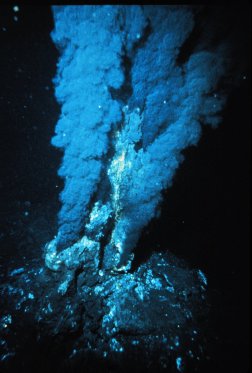
In the 1990s UK researchers, led initially by Joe Cann and Roger Searle, established BRIDGE, the British Mid-Ocean Ridge Initiative
3, a national collaboration to explore the Mid Atlantic Ridge (MAR). Through BRIDGE and its dedicated funding through the NERC, UK researchers developed and deployed new instruments, and set up sesimic and other investigations in key areas along the MAR, in order to describe and understand how the Mid Atlantic Ridge worked. BRIDGE researchers were also part of international collaborations, for example in submersibles and as part of the Ocean Drilling Program. They investigated the pattern of volcanism and tectonics that shaped the undersea landscape on the ridge
4 and integrated heatflow, gravity and seismic surveys to focus on the plume – or lack of it
5,6 – beneath Iceland.
Measurements of localised and diffuse fluid flow at the vents revealed the contribution of vent flows to the chemical budget of the oceans
7, for example, linking ocean fluxes with atmospheric and climate science
8. The discovery that shrimps, mussels and tubeworms thrive at vents thanks to symbiotic bacteria that feed on hydrogen sulphide boosted research on microorganisms that can survive in such extreme environments. Extremophiles, microbes that live at extremes of heat, pH or aridity, are now thought to be the most likely forms of life to be found elsewhere in the solar system and astrobiologists and astrogeologists are devising ways to search for them on Mars, Europa and beyond. These researchers face the same sort of problems that oceanographers tackle: the field area is inhospitable and difficult and expensive to reach; the targets are tiny and rare. Solutions, too, have common threads: robust instruments, clever remote sensing and multidisciplinary research teams.
UK geoscientists now take their place with researchers of varied disciplines to work on the oceans. Much UK expertise is concentrated at the National Oceanography Centre, Southampton, which brings together research and teaching in the relevant disciplines. NOCS manages the national research fleet, including the recently launched RRS James Cook (Geoscientist 17, 4 p4) and has developed robot submersibles to explore new ocean areas, most recently sending the submersible Isis to the seafloor in Antarctica. These approaches, combined with data from increasing numbers of Earth observation satellites such as ESA’s Envisat, is bringing the pattern that Wyville Thomson began to discern in the nineteenth century into sharper focus and allowing the newly-discovered cycles of the ocean basins to take their place in the greater cycles of ocean chemistry and circulation.